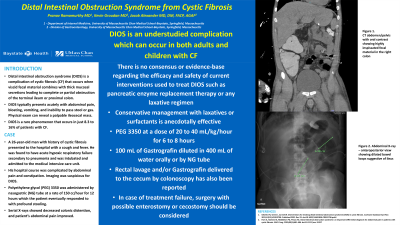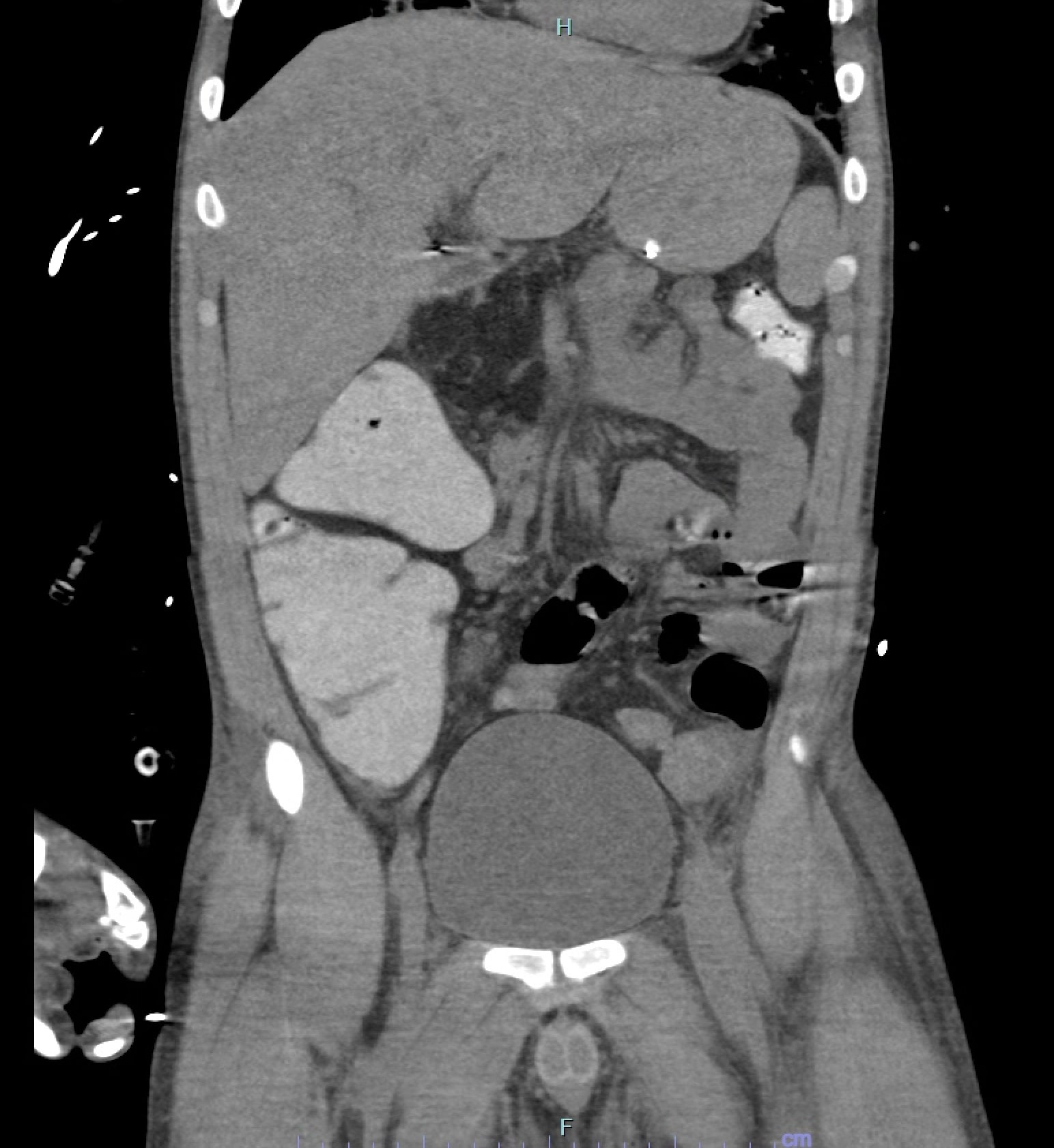Monday Poster Session
Category: Colon
P2034 - Distal Intestinal Obstruction Syndrome From Cystic Fibrosis
Monday, October 28, 2024
10:30 AM - 4:00 PM ET
Location: Exhibit Hall E

Has Audio
- PR
Pranav S. Ramamurthy, MD
University of Massachusetts Chan Medical School - Baystate Medical Center
Springfield, MA
Presenting Author(s)
Pranav S. Ramamurthy, MD1, Kevin Groudan, MD2, Jacob Alexander, MD, DM3
1University of Massachusetts Chan Medical School - Baystate Medical Center, Springfield, MA; 2University of Massachusetts Chan Medical School - Baystate, Springfield, MA; 3Baystate Medical Center, Springfield, MA
Introduction: Distal intestinal obstruction syndrome (DIOS) is a complication of cystic fibrosis (CF) that occurs when viscid fecal material combines with thick mucosal secretions. This leads to complete or partial obstruction of the terminal ileum or proximal colon. DIOS is a rare phenomenon that occurs in just 8.3 to 16% of patients with CF. We present a CF patient admitted with DIOS.
Case Description/Methods: A 26-year-old man with history of cystic fibrosis presented to the hospital with a cough and fever. He was found to have acute hypoxic respiratory failure secondary to pneumonia and was intubated and admitted to the medical intensive care unit. His hospital course was complicated by abdominal pain and constipation. A computed tomography (CT) of abdomen/pelvis with oral contrast showed highly inspissated stool in his right colon (Figure 1). Abdominal x-ray (KUB) showed distention of small and large bowel loops, compatible with distal obstruction or ileus.
DIOS was suspected. Polyethylene glycol (PEG) 3350 was administered by nasogastric (NG) tube at a rate of 150 cc/hr for 12 hours however patient did not have a bowel movement. Gastroenterology (GI) was consulted. GI recommended stopping PEG 3350 and consulting interventional radiology (IR) for Gastrografin enema or alternatively administering Gastrografin by NG tube. Additionally, lifelong daily PEG 3350 and senna were recommended to prevent recurrence of DIOS. Gastrografin could not be obtained, and IR was not familiar with Gastrografin enema, so PEG 3350 was resumed at a rate of 150 cc/hr. Patient had profound stooling after 12 more hours of PEG 3350 so it was discontinued. Serial KUB showed decreased colonic distention, and patient’s abdominal pain improved.
Discussion: DIOS typically presents acutely with abdominal pain, bloating, vomiting, and inability to pass stool or gas. Physical exam can reveal a palpable ileocecal mass. Predisposing factors include insufficient secretion of chloride and water, delayed intestinal transit, and fat malabsorption. Treatment is largely empirical. Conservative management with laxatives or surfactants is effective in 89-96% of cases. Administration of PEG at a dose of 20 to 40 mL/kg/hr for 6 to 8 hours is recommended. Alternatively, 100 mL of Gastrografin diluted in 400 mL of water can be administered orally or by NG tube. Rectal lavage and/or Gastrografin delivered to the cecum by colonoscopy has also been reported. In case of treatment failure, surgery with possible enterostomy or cecostomy should be considered.

Disclosures:
Pranav S. Ramamurthy, MD1, Kevin Groudan, MD2, Jacob Alexander, MD, DM3. P2034 - Distal Intestinal Obstruction Syndrome From Cystic Fibrosis, ACG 2024 Annual Scientific Meeting Abstracts. Philadelphia, PA: American College of Gastroenterology.
1University of Massachusetts Chan Medical School - Baystate Medical Center, Springfield, MA; 2University of Massachusetts Chan Medical School - Baystate, Springfield, MA; 3Baystate Medical Center, Springfield, MA
Introduction: Distal intestinal obstruction syndrome (DIOS) is a complication of cystic fibrosis (CF) that occurs when viscid fecal material combines with thick mucosal secretions. This leads to complete or partial obstruction of the terminal ileum or proximal colon. DIOS is a rare phenomenon that occurs in just 8.3 to 16% of patients with CF. We present a CF patient admitted with DIOS.
Case Description/Methods: A 26-year-old man with history of cystic fibrosis presented to the hospital with a cough and fever. He was found to have acute hypoxic respiratory failure secondary to pneumonia and was intubated and admitted to the medical intensive care unit. His hospital course was complicated by abdominal pain and constipation. A computed tomography (CT) of abdomen/pelvis with oral contrast showed highly inspissated stool in his right colon (Figure 1). Abdominal x-ray (KUB) showed distention of small and large bowel loops, compatible with distal obstruction or ileus.
DIOS was suspected. Polyethylene glycol (PEG) 3350 was administered by nasogastric (NG) tube at a rate of 150 cc/hr for 12 hours however patient did not have a bowel movement. Gastroenterology (GI) was consulted. GI recommended stopping PEG 3350 and consulting interventional radiology (IR) for Gastrografin enema or alternatively administering Gastrografin by NG tube. Additionally, lifelong daily PEG 3350 and senna were recommended to prevent recurrence of DIOS. Gastrografin could not be obtained, and IR was not familiar with Gastrografin enema, so PEG 3350 was resumed at a rate of 150 cc/hr. Patient had profound stooling after 12 more hours of PEG 3350 so it was discontinued. Serial KUB showed decreased colonic distention, and patient’s abdominal pain improved.
Discussion: DIOS typically presents acutely with abdominal pain, bloating, vomiting, and inability to pass stool or gas. Physical exam can reveal a palpable ileocecal mass. Predisposing factors include insufficient secretion of chloride and water, delayed intestinal transit, and fat malabsorption. Treatment is largely empirical. Conservative management with laxatives or surfactants is effective in 89-96% of cases. Administration of PEG at a dose of 20 to 40 mL/kg/hr for 6 to 8 hours is recommended. Alternatively, 100 mL of Gastrografin diluted in 400 mL of water can be administered orally or by NG tube. Rectal lavage and/or Gastrografin delivered to the cecum by colonoscopy has also been reported. In case of treatment failure, surgery with possible enterostomy or cecostomy should be considered.

Figure: Figure 1: CT demonstrating dilated large bowel with highly inspissated stool
Disclosures:
Pranav Ramamurthy indicated no relevant financial relationships.
Kevin Groudan indicated no relevant financial relationships.
Jacob Alexander indicated no relevant financial relationships.
Pranav S. Ramamurthy, MD1, Kevin Groudan, MD2, Jacob Alexander, MD, DM3. P2034 - Distal Intestinal Obstruction Syndrome From Cystic Fibrosis, ACG 2024 Annual Scientific Meeting Abstracts. Philadelphia, PA: American College of Gastroenterology.
